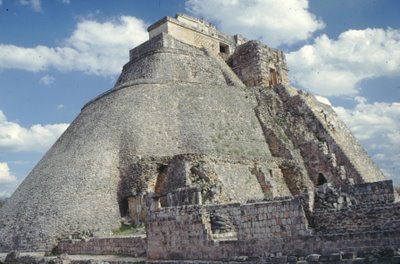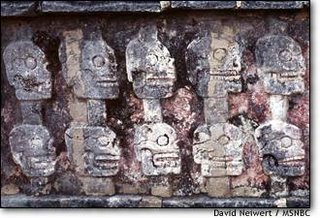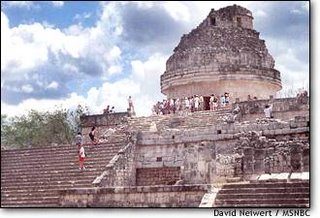
[Note: Following is a piece I wrote for MSNBC.com's Travel section in January 2001, which is no longer available on the Web. I'm republishing it here to supplement the above review of Mel Gibson's Apocalypto.]
By David Neiwert
Special to MSNBC
 The Mayan rain god Chaac -- wide eyes and a scowling brow, long curling snout and a wide, toothy mouth stretched open in a grimace, suggesting either a war cry or hideous laughter -- snarls at the world everywhere you turn in Mexico's Yucatan Peninsula.
The Mayan rain god Chaac -- wide eyes and a scowling brow, long curling snout and a wide, toothy mouth stretched open in a grimace, suggesting either a war cry or hideous laughter -- snarls at the world everywhere you turn in Mexico's Yucatan Peninsula. He most famously appears, of course, throughout the many ruins of the ancient Mayan world: on entire temple walls, cornices adorning palaces, and glaring from atop pyramids, where designers made Chaac's gaping mouth the doorway to inner sanctums.
However, Chaac is not a dead god. He quietly remains alive among the Mayan people who form the bulk of the Yucatan’s populace today. Many Mayans continue to practice their ancient religion, often in rituals conducted out of view of the general public. His visage, in a way, is a concrete symbol of the continuum between that ancient Mayan world and the modern.
Indeed, as archaeologists continue to unravel the "mystery" of the ancient Mayan civilizations, it becomes clear that the original riddle itself was based on a bad premise. The question -- What became of the great city-builders? -- presumed that the seemingly primitive Mayans who led simple farming lives were removed somehow from their forebears who constructed great cities and fought vast wars in the Central American jungle. Now, it's becoming clear that isn't the case.
"One has the impression from the modern representation of the tourist trade that the Maya are simple peasant farmers and always have been, and that there's no real connection between the modern Maya and the people who built the magnificent ruins -- it's kind of a mystery how the ruins got to be built," says David Freidel, an anthropologist at Southern Methodist University in Dallas, and the author of several books on the ancient Maya.
"Magical dwarves at Uxmal and lightning snakes and other such creatures, and ancient kings buried under the Ballcourt at Chichen Itza -- well, those stories are fun and they're part of the rich folklore of the Maya of the area. But they're not the truth. The truth is that the Maya that are around today -- not only are they the direct descendants, but in many cases they are still part of the urban culture, and always have been part of the urban culture, of Yucatan."
The continuum between the ancient Mayans and the modern is not an easy connection for modern travelers visiting the ruins to make, because there seems to be little resemblance between the builders of these awe-inspiring edifices and the generally impoverished Mayan villagers whose homes appear to be little more than thatched huts (though in fact they're ingeniously designed to fit the Yucatan climate). And most tourists' attention is focused, understandably, on the ruins themselves.
It is hard not to be in awe of the Mayan city-builders. The massive pyramids, like the famous Castillo at Chichen Itza, the Iglesia at Coba or the Temple of the Magician at Uxmal are visually stunning structures whose most impressive trait is their architectural perfection. The Castillo, for instance, is designed so precisely that on the day of the spring and autumn equinoxes, the shadow of the pyramid is designed to fall on its snake-headed staircase so that the pillars appear to be the slithering body of a serpent.
 Thousands of visitors climb the steep steps up these pyramids every year -- not an easy feat, particularly on the vertigo-inducing descents. [Note: this is no longer the case; Mexican tourism officials closed off the pyramid stairways a couple of years ago after some tourists were badly injured on them, and they are no longer open to public climbing.] Like many of the surviving Mayan structures, the pyramids served mostly ceremonial purposes, and many of these ancient ceremonies featured bloodletting: beheadings, heart removals and dances involving pierced body parts. You can find evidence of these gory rituals everywhere in Mayan cities, from platforms decorated with skulls to Chaac-mool sculptures that served for beheadings to the ballcourts where the losers, evidence suggests, lost their lives.
Thousands of visitors climb the steep steps up these pyramids every year -- not an easy feat, particularly on the vertigo-inducing descents. [Note: this is no longer the case; Mexican tourism officials closed off the pyramid stairways a couple of years ago after some tourists were badly injured on them, and they are no longer open to public climbing.] Like many of the surviving Mayan structures, the pyramids served mostly ceremonial purposes, and many of these ancient ceremonies featured bloodletting: beheadings, heart removals and dances involving pierced body parts. You can find evidence of these gory rituals everywhere in Mayan cities, from platforms decorated with skulls to Chaac-mool sculptures that served for beheadings to the ballcourts where the losers, evidence suggests, lost their lives.These rituals, which appear barbaric to Western sensibilities, were part of a relatively consistent and logical Mayan religious world view carefully attuned to the four seasons, which dictated their agricultural practices and their social behavior too.
 Other Mayan structures tell the tale of ritual as well. Mayan priests used the Caracol, or Observatory, at Chichen Itza, to gather astronomical data and keep track of the seasons, which they did with astonishing precision. The famed Mayan calendar, with a year comprised of 13 20-day months, was far more accurate and practical than our own Roman calendar.
Other Mayan structures tell the tale of ritual as well. Mayan priests used the Caracol, or Observatory, at Chichen Itza, to gather astronomical data and keep track of the seasons, which they did with astonishing precision. The famed Mayan calendar, with a year comprised of 13 20-day months, was far more accurate and practical than our own Roman calendar. Modern Mayans are still the dominant population in the Yucatan, farming the land as they always have, though many of them are turning to tourism to make a living. You’ll inevitably encounter them in shops, at T-shirt and trinket stands, and offering their services as guides at sites.
"They are remarkably open and friendly, to an amazing degree," says Dr. Bruce Love, a Riverside, Calif.-based anthropologist who has spent the better part of the past thirty years living among and writing about the Mayans in the Yucatan. "You know -- they invite you into their homes, invite you to share their food, their time. Happy to show you things, take you around. Hard-working. They just have a lot of real quality characteristics."
Though today's Mayans certainly do not cut out the hearts of sacrificial victims, ancient rituals survive. Integrating their indigenous beliefs with a layer of Catholicism, the Mayans continue to rely on native priests, especially when the need for rain arises.
Then, the village's shaman gathers everyone at a clearing in the forest for a day-long ritual called the Ch'a Chaac. A wooden altar with leaf arches is laden with sacred breads wrapped in leaves, sometimes shaped like animals. At one point during the ceremony, little boys squat under each corner of the altar and croak like frogs, which are always considered a sign of rain.
Bruce Love has witnessed these ceremonies, but they generally are not on view for the average tourist. "Most of these ceremonies are done far away from the main population centers, in small towns and villages, oftentimes out in the forest itself," he says. If a white person wants to watch one, it takes time. "It's something you have to build up to gradually, but there is the beginnings of cultural tourism, and so you see ceremonies performed for tourists. They are not really ceremonies -- they’re just done just for tourists. And that's beginning to happen more and more in Mayan areas."
In other regions with heavy Mayan populations -- notably Guatemala, Belize and Chiapas -- there have been increasing reports of a resurgence in Mayan religious ceremonies. And Love sees no sign that the ancient beliefs are on the wane. "I see no sign of it disappearing. It's a little bit hard to believe that when one is doing a tour and one is at the hotels on the highways and in the restaurants, because one tends just to see the outer surface. But once you get back off the main roads and into the villages, it's just such a strong and powerful culture, a coherent culture, that it's just not about to disappear."
 In a way, this only deepens the mystery of the ancient cities. If the Mayans and their culture are still thriving, then why did they abandon such magnificent homes? If they simply blended back into the jungle and returned to the farmed milpas, or cleared jungle tracts that had sustained them for centuries, what was the reason?
In a way, this only deepens the mystery of the ancient cities. If the Mayans and their culture are still thriving, then why did they abandon such magnificent homes? If they simply blended back into the jungle and returned to the farmed milpas, or cleared jungle tracts that had sustained them for centuries, what was the reason?Recently, modern researchers have uncovered possible answers. According to Freidel, a combination of socio-political disruptions and ecological disasters brought a close to the era of city-building for some Mayan cultures, while wars and military action destroyed others, including Chichen Itza.
But the Mayas were always city dwellers as well as farmers, even at the time of the Spanish conquistadors' arrival in the 16th century. However, both Love and Freidel cite the devastation wrought by disease from contact with Europeans which wiped out some two-thirds of the Mayan population as a major cause of the Mayans' real cultural decline. However, they say, the Maya have always nurtured a sophisticated, literate culture -- despite the efforts of their conquerors to force them into economic and cultural submission.
"It's not just a matter that the Maya are alive and well and living where their ancestors lived," Freidel says. "It is that the Maya of Yucatan -- along with the Maya of Highland Guatemala and other areas -- have been continuously urban and civilized people for more than 30 centuries. These people never stopped living in urban places.
"Cities like Tehu became Merida; Valladolid sits on an ancient ruin; Izamal sits on an ancient ruin. Most of the major towns of the Yucatan have ruins either inside their city limits or very close by, because that's where the Spanish settled into the countryside and gathered the people for purposes of conversion and also to harness their labor for the new colonial economy. But the Maya of those areas have always been urban."
Indeed, Freidel says, many of the ruins that attract visitors now were continuously inhabited from the time of their construction centuries ago.
"A city like Uxmal was never lost -- it was always part of the landscape, always part of the story of the Maya, and always inside an urban civilization that the Maya always were part of."
No comments:
Post a Comment